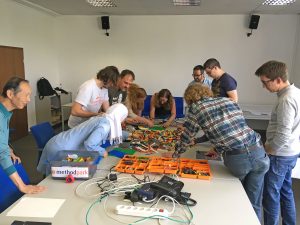Lately, the newest addition to our Certified Method Park Engineer training program was announced: the LEGO® Scrum Simulation. Having briefly read about #LEGO4SCRUM before, I knew it is about bringing ad hoc Scrum teams to life for some actual brickwork. My curiosity was sparked how this playful approach would lead us to immerse into Scrum in the four-hour training. Hence, I eagerly signed up when the first session was scheduled.
Setting the stage for a fast-paced agile journey
The training suits groups ranging from nine up to fourteen participants. It is explicitly open to agile practitioners and novices alike. So it attracted many colleagues at Method Park. Among others, consultants, marketing experts, scrum masters and software engineers joined our motley group.
Our journey into agility started off with a short introduction into the basic elements of Scrum. Following that crash Course about Scrum Masters, sprint reviews and story points, we started with the practice. Our product: A whole city built from scratch out of LEGO® bricks!
The user-journey
First, we got a small impression of the product owner’s role. Creating personas and user journeys, we developed a common vision of our upcoming product. Designing actual inhabitants for our brand-new city and envisioning their daily lives for sure was a creative process. Along the way, we exchanged experiences about topics like the challenges of requirements engineering, estimation techniques and the concept of a minimum viable product. From now on, the product owner was represented by one of our two trainers. They even brought a stash of pre-written requirements, but most of those were already well covered by the user stories we had worked out ourselves.
Our scrum-journey
After we randomly divided into two Scrum teams, each team appointed a Scrum Master. In the scope of the simulation, the Scrum Master’s role was foremost to observe the sprints and offer insights and guidance in the retrospectives. With everything set-up, we conducted multiple six-minute sprints accompanied by refinements and retrospectives.

Our skilled moderators enforced some of the common ups and downs of day-to-day’s work. For example, they assigned related stories to different teams. While that worked out perfectly for a hospital with an affiliated casualty department and did speed-up feature completion, it later caused serious trouble when the newly build train was by magnitudes too large for the trackage. We also experienced the effects of insufficient acceptance criteria, far-off estimates and too coarse-grained user stories. Of course, also the requirements changed at some points. For example, an important request for solar panels arose quite unexpectedly. It led to a rebuild of the whole supermarket’s rooftop later. But overall, while the training’s meta-level goal focused the Scrum experience itself, we did also quite well for our „product“: We realized our vision of a viable city as well as several extra features like an ambulance car.
Take-home messages
Besides the LEGO® Scrum Simulation approach itself, what might be a souvenir to take away from our journey? The restricted role of the Scrum Master within the simulation’s framework pointed out how crucial it is, especially in fast-paced environments, to take time to observe and reflect. Retrospectives are key. It was a pleasure to observe how my team gained insights into the retros and gradually improved with each iteration.
In the end, the positively playful training turned out to be a suitable first introduction to Scrum for the novice as well as an insightful journey for the versed practitioner. Sure, the novice won’t be equipped with all the common theory afterwards. But they have gained a basic understanding of the most crucial inner workings of Scrum and, most importantly, got a glimpse of the potential it can enfold when lived in actual real-world projects.
LEGO, the Minifigure and the Brick and Knob configurations are trademarks of the LEGO Group, which does not sponsor, authorize or endorse this website.
- The LEGO Scrum experience, or: Building a city in half a day - 27. September 2018



